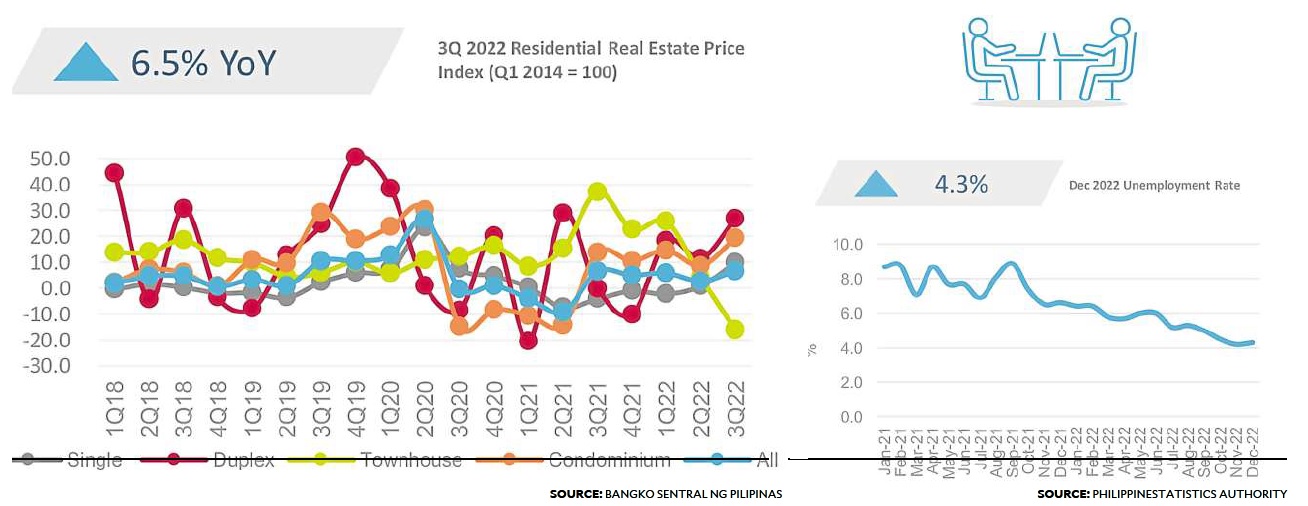
POSITIVE SIGNS Improving real estate prices and declining jobless rate bode well for the local property industry. —GRAPHICS FROM CUSHMAN & WAKEFIELD
Office vacancy rates across the country will continue to rise in the near term before trending lower in the latter part of 2023 amid resilient demand from business process outsourcing (BPO) companies and multinationals seeking to expand in the Philippines.
Real estate services firm Cushman & Wakefield expects the average vacancy rate to hit 15 percent by the end of the year from 16.13 percent in the fourth quarter of 2022, which was amplified by the exit of some China-focused Philippine offshore gaming operators (Pogo) companies.
While an improvement, demand is still seen to hover below prepandemic levels as the spectre of elevated inflation clouds the outlook for the economy.
“Inflationary pressures and the expected global slowdown will continue to delay occupancy and real estate investment decisions,” says Claro Cordero, director and head of research, consulting and advisory services at Cushman & Wakefield.
“As many corporate occupiers remain unsure about their future office needs coupled with the advent of hybrid work practices, the growth of office space demand and other allied property sectors will thread below prepandemic levels,” he added.
Last week, the Bangko Sentral ng Pilipinas raised the key policy rate by 0.5 percentage points to 6 percent. It also raised the full year inflation forecast to 6.1 percent due to elevated food, transport and wage costs.
Cordero notes, however, the industry’s recovery is still “on track.”
Prospects better for landlords
“Positive rental growth is likely to happen in 2023 as delayed prospects are expected to get a green light this year, giving confidence to developers and landlords to test resistance levels on the prepandemic published rates, while overall market vacancy tapers down,” he said. The looming global recession is also seen to increase demand for the Philippine outsourcing firms, which are among the largest office leasing tenants in the country.
Another potential driver is seen to come from “rekindled interest of multinational companies looking at setting up back office or shared services operations in the country, according to Tetet Castro, director and head of tenant advisory group at Cushman & Wakefield.
“While market recovery continues in [the fourth quarter] 2022, we still see a possibility of a slight increase in average vacancy rates from the previous quarter, as well as a slight dip in asking rents, primarily due to the addition of new stocks from new building completions as well as nonrenewal or early return of space by occupiers continuing their exercise of right-sizing or converting to a hybrid set-up,” says Castro.
Tide lifts all boats
Other property segments such as retail, industrial and logistics are also seeing better prospects this year.
“[R]evenge spending has buoyed the retail segment in 2022 with footfall in key establishments reverting close to the pre-COVID-19 level in the latter part of the year,” the company says.
At the same time, the industrial and logistic sector will benefit from the continued expansion of online retail. The upward trend in domestic manufacturing will also improve demand for standard factory buildings from traditional locators, Cushman & Wakefield notes.
The residential sector is also seen to recover at a more gradual pace.
“Demand for residential condominiums in key business districts is slowly reverting to a positive trend as business activities have begun to normalize,” Cordero says.
“Movements in completion dates were made for several projects during the pandemic due to subdued demand in the last two years. While the higher interest rates are likely to have little effect on the high-end residential segment, greater impacts are likely to be observed in the mid-market residential segment in the medium term,” he adds. INQ